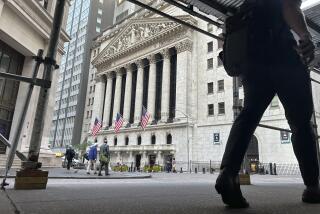Dow Rebounds 88 Points : But Other Stocks Lag on 4th-Heaviest Trading Day : Nearly Half of Friday’s Loss Erased
- Share via
NEW YORK — Blue chip stocks rallied 88 points today, rebounding from Friday’s 190.58-point plunge, the worst setback on Wall Street since the crash of 1987. But share prices of many other companies trailed behind.
The Dow Jones average of 30 industrials, which sank more than 50 points in the opening minutes of trading, closed at 2,657.38, a gain of 88.12 points, in massive trading of 416.29 million shares. It was the fourth-biggest Big Board volume in stock market history.
Declining issues outnumbered advances by about 5 to 4 on the New York Stock Exchange, with 942 down, 766 down and 286 unchanged.
The NYSE’s composite index gained 4.21 to 189.77.
At the American Stock Exchange, the market value index declined 2.04 to 376.41.
For most of the day, stocks rocked back and forth as substantial price declines encouraged buyers to go after bargains, which helped lift the Dow Jones industrial average. Computer-driven program trading intensified the swings.
In Washington, the Federal Reserve made good on its promise to keep the markets moving by injecting $2 billion into the banking system. Analysts described the move as restrained.
The Fed had indicated over the weekend that it would move quickly to meet any demands for cash that might result from a deluge of sell orders hitting the U.S. markets.
Analysts were encouraged that the market today avoided a repeat of the collapse two years ago when the Dow shed 508 points.
Most of the stocks that comprise the Dow average posted gains.
“When you get into a period like we’re in now, there’s always a flight to quality,” said Montgomery Securities Inc. partner Robert L. Kahan in explaining the discrepancy between the Dow and the broader market.
Analysts said program trading exacerbated the discrepancy between the Dow and the broader market. Program traders “buy much more narrow baskets of stocks than people tend to think,” said Guy Stern, a research analyst at ADB Securities Corp. “They’re not buying 250 (different) stocks, it’s more like 25.”
Volume was even heavier than on Black Monday, Oct. 19, 1987, said Richard Torrenzano, the New York Stock Exchange’s chief spokesman.
The Big Board’s computer system was expanded following the crash to be able to accommodate 600 million shares a day.
Analysts said stock prices would have difficulty stabilizing. “ . . . Perhaps through the next week or so we will experience a continued high degree of volatility,” said Jack Conlon, an executive vice president at Nikko Securities Co. International Inc.
“It’s very difficult to tell where we are,” said Hugh Johnson, first vice president at First Albany Corp. Bargain-hunting institutional investors bought high-quality stocks, which helped push up the Dow, but Johnson said the fact that the broader market was still off was troublesome.
The dollar’s value sank in early trading today in Europe and in Tokyo before recovering somewhat. Bond prices moved higher.
More to Read
Inside the business of entertainment
The Wide Shot brings you news, analysis and insights on everything from streaming wars to production — and what it all means for the future.
You may occasionally receive promotional content from the Los Angeles Times.










